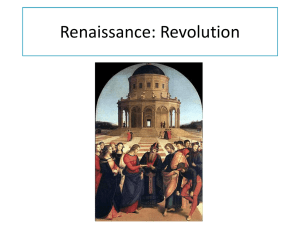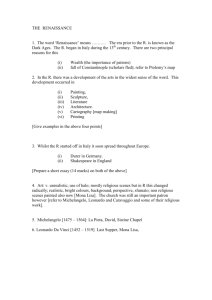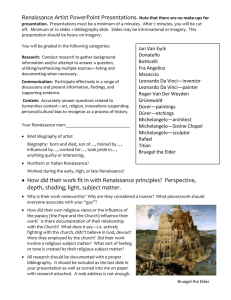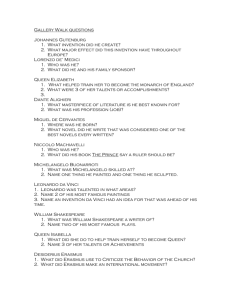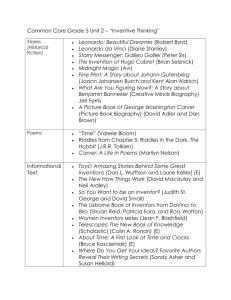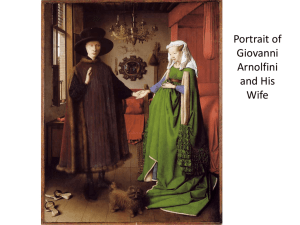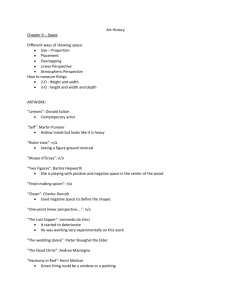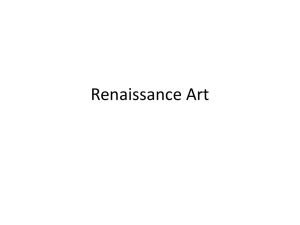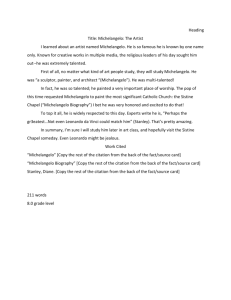Leonardo Da Vinci - MariemontSocialStudies
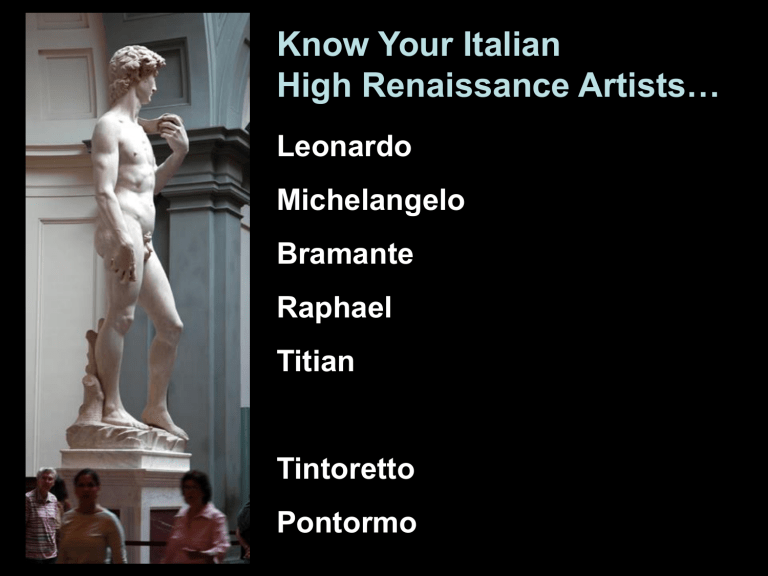
Know Your Italian
High Renaissance Artists…
Leonardo
Michelangelo
Bramante
Raphael
Titian
Tintoretto
Pontormo
Leonardo da Vinci
Leonardo was the quintessential
“Renaissance Man”, studying all types of subjects. He was an Artist, Sculptor,
Architect, Scientist, Engineer and Inventor.
Worked as an apprentice to Verrocchio
Self-Portrait drawing , c1512.
Leonardo da Vinci
Leonardo Da Vinci , “Virgin of the Rocks”
1485 . Oil on wood (transferred to canvas), approx. 6’3” x 3’7”. Louvre Paris .
Leonardo da Vinci
Excerpts from da Vinci’s Notebook
Leonardo da Vinci
Excerpts from da Vinci’s Notebook
Leonardo da Vinci
Excerpts from da Vinci’s Notebook
Leonardo da Vinci
Leonardo da Vinci
Leonardo da Vinci
Leonardo da Vinci
Despite it’s ruined state and its restorations, this piece is by far the most impressive of Leonardo’s works.
Christ and his 12 disciples are seated at a long table set parallel to the picture plan in a simple, spacious room. Leonardo amplified the painting’s highly dramatic action by placing the group in an austere setting.
Christ appears isolated from the disciples, framed by the window behind him. It serves as a halo.
The artist took people out of his real life and used them as figures for his painting, but had problems with Judas because he couldn’t find a significant figure for him.
When he did finally paint him, he portrayed him with his hand over a dish because of Christ’s foretelling that “he that dippeth his hand with me into the dish, he shall betray me” refering to Judas’ betrayal. He is also leaning back from Christ and in a shadow. Christ was the last to be painted.
Leonardo Da Vinci.
“Last Supper” ca. 1495-1498.
Fresco.
Leonardo da Vinci
Divine THREEs: Trinity & Theological Virtues
Earthly FOURs: Elements & Cardinal Virtues Leonardo Da Vinci.
“Last Supper” ca. 1495-1498.
Fresco.
Leonardo da Vinci
World’s most famous portrait. Leonardo took three years to finish the portrait and it is said to be of Lisa di Antonio Maria
Gherardini, the wife of a wealthy
Florentine. It was his favorite piece
– so much so that Leonardo kept it for years.
Leonardo Da Vinci, “Mona Lisa” ca. 1503-1505.
Oil on wood, approx 2’6” x 1’9”. Louvre, Paris.
Leonardo da Vinci
Portrait of Mona
Lisa Giaconda OR
Self-Portrait of Da
Vinci?
Leonardo da Vinci
“Portrait of Ginerva Benci”, Oil on Wood, 1474-76.
“Virgin of the Rocks”,
1485 . Oil on wood.
.
Michelangelo
In 1501, the city of Florence asked Michelangelo to work a great block of marble, called “The
Giant,” left over from an earlier aborted mission.
From this stone, David was sculpted, the defiant hero of the Florentine republic and, in so doing, assured his reputation then and now as an extraordinary talent.
David’s formal references to classical antiquity appealed to Julius II, who associated himself with humanists and with Roman emperors.
Thus, this sculpture and the fame that accrued to Michelangelo on its completion called the artist to the pope’s attention, leading to major papal commissions.
The artist chose to depict David not after victory, but turning his head to his left, sternly watchful of the approaching foe. His whole muscular body, as well as his face, is tense with gathering power.
Michelangelo, David
Galleria dell’Academia, Florence, Italy
1501-1504
Michelangelo
Michelangelo worked for the
Medici family in Florence
Claimed to have taught himself to carve marble by studying the
Medici collection of classical statues
Michelangelo, David
Galleria dell’Academia, Florence, Italy
1501-1504
Michelangelo
It’s a larger than life sculpture, the height of David reaches over 13 feet tall. It’s also sculpted in perspective (top heavy), so if viewed from below the figure looks proportional. Contrapposto or a weight shift is also apparent in this sculpture.
Michelangelo
Exterior of Sistene Chapel
Michelangelo
Pope Julius II gave the reluctant Michelangelo the commission to paint the ceiling of the Sistene
Chapel.
Michelangelo faced enormous difficulties: relative inexperience in fresco technique, large dimensions, height above pavement, and perspective.
Depicting the most august themes of all, the
Creation, Fall, and Redemption of humanity,
Michelangelo spread a colossal decorative theme with over 300 figures.
A long sequence of narrative panels describing the creation, as recorded in the biblical book
Genesis, runs along the crown of the vault.
The hebrew prophets who foretold the coming of
Christ appear seated in large thrones on both sides of the central row.
Michelangelo , Ceiling of the Sistine Chapel
Rome, Italy 1508-1512
Michelangelo
Michelangelo , Ceiling of the Sistine Chapel
Rome, Italy 1508-1512
Michelangelo
Michelangelo , Ceiling of the Sistine Chapel
Rome, Italy 1508-1512
Michelangelo , Ceiling of the Sistine Chapel
Rome, Italy 1508-1512
Michelangelo
Ceiling of the
Sistine Chapel
Rome, Italy
1508-1512
Michelangelo
The Last Judgment
Fresco
Sistine Chapel, Italy
1541.
Biago da Cesena
(the Pope’s Master of Ceremonies) painted as Minos,
Ruler of Hell
Michelangelo
Michelangelo, Pietà, from Old St. Peter’s, c1500, Marble, height 5’8.5”
Pietà = Virgin Mary holding and mourning dead Christ
Italian for “compassion”
Popular in Northern
Europe, but rare in Italy
Made by Michelangelo when he was 24
Only major work that has
Michelangelo’s signature on it (on the strap across her chest)
Rogier Van Der Weyden,
Pieta, 1450, Oil on Panel.
Michelangelo
Latin for
“Michelangelo
Buonarroti
Made This”
Michelangelo
“An American Pietà”
St. Peters, Rome
1506 Bramante designs a
Greek-Cross plan for a new St. Peter’s to replace the old church.
1514 Bramante dies, and the building of the church is put on hold for over 30 years.
1546 Michelangelo becomes
Chief Architect for the building of St. Peter’s… built up to the dome.
1630 Painting of St. Peter’s
